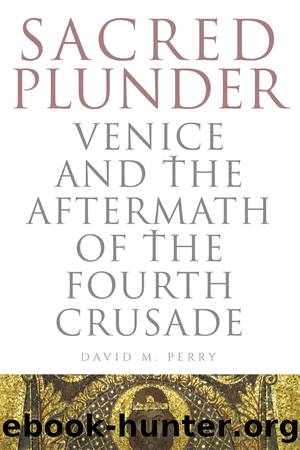Sacred Plunder by Perry David M

Author:Perry, David M.
Language: eng
Format: epub
Publisher: Pennsylvania State University Press
Published: 2015-06-15T00:00:00+00:00
PART III
_______________________________________
OUTCOMES
5
____________________________
Translatio and Venice Before and After 1204
The previous four chapters of this book have examined the translatio narratives of the Fourth Crusade in their immediate contexts and in comparison to one another. But each discrete act of hagiographical memorialization operated within highly localized diachronic cultural systems. Specific cultural norms governed the sites in which hagiographers engaged in contesting the memory of the Fourth Crusade. These localized norms interacted with the pressures from Rome, the stories generated by returning soldiers, and other respondents to the events of 1204. Pull on any narrative thread from any one of the sites that produced translatio texts and you will find long cultural chains connecting a specific narrative to its locality.
In most cases, the interaction between local culture and translatio seems to have been unidirectional. New relics may have reshaped or refocused localized devotional practice, but commemorative practices generally reflected local traditions instead of transforming them. In most cases, we lack evidence that would link the relics of 1204 to broader cultural change. Venice provides an exception. This chapter places the Venetian hagiographical responses to the Fourth Crusade at the heart of Veniceâs cultural transformation in the thirteenth century. Venetian translatio narratives, for all their paucity and erratic composition, offer a window onto the metamorphosis of Venetian identity that began after the Fourth Crusade. The narratives link the cultural history of the merchant republic of the eleventh and twelfth centuries to the mighty but imperiled maritime empire of the later Middle Ages.
The totality of the way in which late medieval and early Renaissance Venetians integrated their myths into their lives has long impressed scholars.1 By the late thirteenth century, Venetian âmythmakers,â including church and state leaders, artists, and historians, began to reshape cultural narratives based on a new understanding of Veniceâs unique past. By the fourteenth century, the mythmakers had gone a step further and reimagined their history from the very beginning, inventing new stories when the old ones did not seem to be sufficiently august. Mythographers such as Doge Andrea Dandolo (ca. 1307â1354) subordinated all forms of media to the purpose of reinforcing the Venetian myths. Works of history and art, civic ritual, political posturing, epistolary traditions, architectural choices, and even the explicit policies enacted by the rulers all reflected Veniceâs constructed self-perceptions. Out of a reimagined glorious past, the mythmakers of Venice hoped to prove the eternal nature of the cityâs perfection.2
By the fifteenth century, the myth and anti-myth of Venice had been firmly established not only in the Veneto but throughout Venetian terra firma and the broader Mediterranean world. The positive view presented a city of free people who had ever protected their independence and whose patriciate was composed of wise and pious rulers who protected the common good, practiced perfect justice, and patronized the arts. To those opposed to Venice, the Venetians were domineering megalomaniacs who cared only for their own power and avaricious gains and would use anyone and any justification to get their way.3 As James Grubb writes,
Download
This site does not store any files on its server. We only index and link to content provided by other sites. Please contact the content providers to delete copyright contents if any and email us, we'll remove relevant links or contents immediately.
| Belgium | France |
| Germany | Great Britain |
| Greenland | Italy |
| Netherlands | Romania |
| Scandinavia |
Room 212 by Kate Stewart(5073)
The Crown by Robert Lacey(4764)
Endurance: Shackleton's Incredible Voyage by Alfred Lansing(4722)
The Iron Duke by The Iron Duke(4323)
The Rape of Nanking by Iris Chang(4170)
Joan of Arc by Mary Gordon(4058)
Killing England by Bill O'Reilly(3973)
Say Nothing by Patrick Radden Keefe(3938)
I'll Give You the Sun by Jandy Nelson(3397)
Shadow of Night by Deborah Harkness(3327)
Hitler's Monsters by Eric Kurlander(3293)
Mary, Queen of Scots, and the Murder of Lord Darnley by Alison Weir(3177)
Blood and Sand by Alex Von Tunzelmann(3168)
Eleanor & Park by Rainbow Rowell(3116)
Darkest Hour by Anthony McCarten(3097)
Margaret Thatcher: The Autobiography by Thatcher Margaret(3052)
Book of Life by Deborah Harkness(2895)
Red Famine: Stalin's War on Ukraine by Anne Applebaum(2894)
The One Memory of Flora Banks by Emily Barr(2834)
